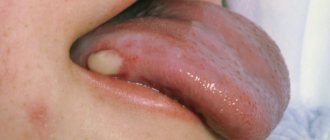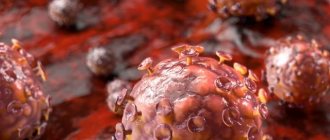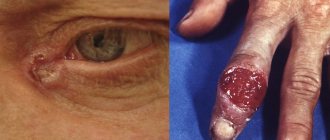If you begin to notice the dubious formation of growths in the lip area, which in appearance resemble small blisters or warts, consult a doctor. Perhaps these growths are nothing more than papillomas. These are benign formations that can spoil a person’s aesthetic appearance and affect the quality of life.
general information
Condylomas are a benign tumor formation that is “located” on the epidermis or mucous tissues and looks like warts and papillae. Single specimens (about 7 mm) or entire “colonial formations” (up to several tens of mm) of condylomas settle on the body of women and men and often resemble cauliflower in appearance. The color of these substances ranges from flesh-colored to brown. Condylomas are viral in nature, so such problems can even occur in children (during childbirth from an infected mother). As long as the growth has not reached the epidermis, the person does not pose a threat to others; the risk of infection increases if the growths are located in the epidermal layer. Condylomas are usually divided into two types:
- wide;
- pointed.
In the first case, condylomas in women and men look like a mushroom with a cap and a wide stalk and are most often a consequence of secondary stage syphilis. Condylomas of the genital type are transmitted through sexual relations; the human papillomavirus (HPV), which is activated under certain conditions, is involved in their appearance. The main location of genital warts is the genitals and oral cavity. Condylomas in women settle on the outer and inner parts of the labia, in the vagina, clitoris and anus. Warts and papillary growths in men select the glans penis and frenulum of the foreskin.
Reasons for appearance
“What causes condylomas?” - a question that worries patients with a similar problem. The route of infection with condylomas is through unprotected sexual contact. Moreover, these include traditional intimate relationships, as well as oral, anal and homosexual relationships. Children get the disease from sick women while moving through the birth canal. Do not be negligent about household methods of infection. There is no need to take risks and use other people’s personal belongings, especially bath accessories (washcloth, towel, flip flops, etc.). Condylomas are activated under the influence of certain factors:
- indiscriminate unprotected sex;
- early onset of intimate relationships;
- sexual contacts with partners with condylomas or HPV carriers;
- decreased immune abilities of the body;
- previous diseases of the genital tract;
- frequent stress, vitamin deficiency;
- sloppiness and failure to comply with personal hygiene rules.
The appearance of genital warts is often associated with HPV. Human papillomavirus infection poses a great danger for the development of cancer. Condylomas of this etiology are the object of study and treatment by doctors of different specializations: in women - by gynecologists, in men - by urologists. If the location of condylomas is in the anal area, then a proctologist leads the patients. You should definitely consult about genital warts, because the development of the disease can occur in a variety of ways - from self-healing to the degeneration of condylomas into malignant formations. The specialists of the Global Clinic Center have accumulated positive experience in solving such problems, so contacting the clinic is a prerequisite for successful treatment of the patient.
Symptoms
The main manifestation of growths is their unpleasant and repulsive appearance. But women will also be reminded of condylomas by other unpleasant moments. The time elapsed from the first contact-infection to the moment when condylomas become clearly visible can be completely different. Sometimes a week or a month is enough for condylomas to appear; in other situations, years may pass. The incubation period depends on the general health of the woman or man, their immunity, lifestyle, etc. Condylomas in women and men cause itching and burning in the genital area and near the anus. This occurs during the period of germination of condylomas; in the future, such symptoms may disappear. An increase in the amount of whitish discharge, sometimes mixed with blood and an unpleasant odor, provokes condylomas in women, which are localized on the vaginal mucosa or cervix. When condylomas are found in the anus, the passage of feces can injure them and cause ichor.
Pathogenesis of genital warts
HPV is found in the cellular structures of the skin and mucous membranes, so it can be transmitted from men to women, from adults to children. The long latent period of infection makes early diagnosis of the disease difficult. Condylomas are not immediately visible to the naked eye. To activate HPV, a large number of these pathogens is necessary, only then the papillomavirus “comes out”, represented by genital warts. An increase in HPV may occur due to decreased immunity in women or men. Genital condylomas are caused by the process of atypical reproduction of the human papilloma virus; under its influence, epithelial cells grow and develop with pathology. The skin and mucous tissues change and this is how condylomas appear. Growths in the form of warts and papillae can be single or massive, turning into entire “conglomerates” of condylomas.
Asymptomatic carriage of human papillomavirus (HPV)
In reality, many more people are infected with HPV than statistics show. Most of them simply do not know about it, since there are no symptoms of condyloma.
The virus may not manifest itself in any way for a long time, since the human immune system does not allow it to develop to the required extent. However, at any time, with a decrease in both general and local immunity, this can happen, and then papillomas and/or condylomas appear.
1 Laboratory diagnostics
2 Dermatoscopy
3 Extended colposcopy
Diagnostics
Human papillomavirus infection (genital warts) is diagnosed in different ways, from visual examination of women and men to the most advanced examinations. CM "Global Clinic" has in its arsenal the latest techniques for determining the nature of condylomas. Diagnostic methods used by doctors:
- Clinical examination. Some types of diseases in women and men can be masked, taking the form of genital warts, so you need to have sufficient qualifications to differentiate different problems.
- Colposcopy is recommended for women, and urethroscopy for men.
- A smear will tell a lot about condylomas in women and their nature; this cytotest will also help to exclude cervical dysplasia.
- Histology.
- Diagnostics-PCR. This examination not only detects the presence of human papillomavirus, but also determines its type.
- Immunological research. It is used to detect antibodies to HPV in the blood.
All women and men affected by genital warts must be tested for infectious diseases of the genital area (syphilis, HIV, etc.)
How is the papillomas removal procedure performed?
Laser is most often used to remove papillomas; it is excellent for work if you need to remove many small papillomas. If you need to remove papillomas larger than 5 mm, we recommend the radio wave method. The methods are absolutely safe, do not injure deep skin tissues and leave no cosmetic defects such as scars. Laser and radio wave methods also have some advantages compared to other methods:
- There is no bleeding because the vessels are instantly cauterized;
- Thanks to coagulation of the bed where the papilloma was located, the risk of infection is reduced;
- Fast healing and short rehabilitation period;
- The risk of recurrence of papilloma is close to zero.
Taking into account the test results and visual examination, an experienced specialist will individually select an effective and safe method for removing papillomas.
Prices for removal of papillomas on the face
How many procedures do you need to undergo to remove papillomas on the face?
Removal of papillomas on the face occurs in just one procedure, however, in case of multiple formations, a repeat visit may be necessary. During the procedure, up to 20-30 papillomas can be removed, and in some cases more.
In the postoperative period, caring for the bed of a removed papilloma is not much different from the same manipulation with moles.
Treatment
Condylomas and HPV require a systematic approach to treatment.
Medication
To combat condylomas in women and men, doctors act in three directions:
- against viruses;
- in order to increase immunity;
- for fortification of the patient.
Cycloferon and inosiplex act against HPV activation and its reproduction. Inferon and allokin-alpha stop viruses and help restore the immune system. To improve the general health of women and men, Immunal, Amixin, Poludan, etc. are prescribed. A complex of vitamins and minerals is also an essential component of treatment for condylomas.
Local
Condylomas are successfully treated using ointments and sprays of antiviral action (epigen-intim, condylen, etc.). Women and men will not have to think about condylomas if they are treated with inquimod, podophyllotoxin. For pregnant women, you can use trichloroacetic and nitric acids. Women need to fight condylomas in stages: first remove them, and then, or in parallel, act to reduce the number of viruses. Often (in every third woman) condylomas enter the stage of relapse (especially if preventive measures are not followed and the recommendations of the attending physician are ignored).
Removal
Methods for removing condylomas in modern medicine are varied:
- Electric coagulation. This method has disadvantages - many contraindications, painful procedure and long recovery.
- Cryotherapy. Condylomas are removed using liquid nitrogen. The positive aspects of this technique are the absence of scars, painless effects, and the absence of anesthesia.
- Surgical method. The growths are removed during surgery, and stitches are placed at the site of the wounds. Doctors use local anesthesia.
- Use of chemicals. This method is contraindicated during pregnancy and lactation.
- Laser therapy. Condylomas are removed with a laser beam; this is a treatment that does not affect healthy cells and leaves virtually no scars.
- Radiosurgical method. The use of a special device helps remove condylomas without contact with the body. Removal of growths is accompanied by simultaneous sealing of blood vessels. This technique is one of the most modern and in demand.
Removal
Once the benign quality of the formation is determined, it is recommended to get rid of it to prevent possible complications in the future and a good cosmetic result. Regardless of the method chosen, a number of rules are of great importance:
- If the approach does not involve immediate removal, then it is forbidden to remove what is left - the crust should fall off on its own. Otherwise, there is a risk of infection and the formation of an unsightly scar.
- After the procedure, you should avoid prolonged exposure to the sun: the lip should be protected from ultraviolet radiation.
- Having removed the manifestations of HPV on the lips, you should stop using lipstick until complete healing.
Preventing HPV infection
Condylomas must be prevented by preventive measures:
- use of contraceptives during sexual relations;
- increasing immunity;
- proper balanced nutrition;
- taking vitamins;
- compliance with hygiene standards;
- fight against bad habits;
- increasing stress resistance.
Regular visits to the doctor are a good preventative measure. The use of antiviral ointments, as well as vaccination against HPV, is prevention that will make people’s lives full.
Pregnancy and condylomas
Condylomas are an alarming signal for pregnant women. HPV in the body of the expectant mother does not have a harmful effect on the fetus, but such a lady must be under the supervision of the attending physician at all times. You can resort to removing growths only at the 28th week of pregnancy, not earlier. If the formations have settled on the genitals, then there is a high probability that the baby will acquire HPV while passing through the birth canal. If the infection is not treated, then the unpleasant moments associated with thrush increase in pregnant women. The best option is a thorough examination before pregnancy for HPV and, if it is detected, mandatory and complete treatment.
Doctors' opinions on the most effective methods of treating warts and papillomas
The chief physician of Moscow City Hospital No. 62 describes his vision on this matter. Anatoly Nakhimovich Makhson Medical practice: more than 40 years.
“I have been treating people’s papillomas and warts for many years. I’m telling you as a doctor, papillomas along with HPV and warts can really lead to serious consequences if they are not dealt with.
The human papillomavirus is present in everyone on whose body there are papillomas, moles, warts and other pigmented formations. According to rough estimates, 80-85% of the planet's population has it. By themselves they are not dangerous. The problem is that an ordinary papilloma can become melanoma at any time.
These are incurable malignant tumors that kill a person in just a few months and from which there is no salvation.
Unfortunately, in Russia and the CIS countries, pharmaceutical corporations sell expensive medications that only relieve symptoms, thereby hooking people on one drug or another. That is why in these countries there is such a high percentage of cancer diseases and so many people suffer from “non-working” drugs.
The only drug that I want to recommend, and it is also officially recommended by WHO for the treatment of papillomas and warts, is Papinol. This drug is the only remedy that has an effect not only on external factors (that is, it removes papillomas), but also acts on the virus itself. At the moment, the manufacturer has managed not only to create a highly effective product, but also to make it accessible to everyone. In addition, within the framework of the federal program, every resident of the Russian Federation and the CIS can receive it for 149 rubles.”
To find out more, read this article.











